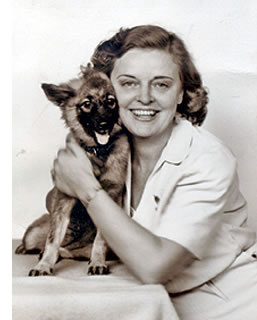 The Diabetes Research Institute Foundation
and the University of Miami Sylvester Comprehensive Cancer
Center jointly announced their receipt of a $35.6 million
gift from the estate of the late Eugenia Dodson of Coral
Gables. The gift, to be split between the two leading
research centers on a two-thirds, one-third basis respectively,
was specifically designated by the donor to be used for
cure-focused research in the two diseases that had affected
her and her brothers. The Diabetes Research Institute Foundation
and the University of Miami Sylvester Comprehensive Cancer
Center jointly announced their receipt of a $35.6 million
gift from the estate of the late Eugenia Dodson of Coral
Gables. The gift, to be split between the two leading
research centers on a two-thirds, one-third basis respectively,
was specifically designated by the donor to be used for
cure-focused research in the two diseases that had affected
her and her brothers.
Eugenia “Gene” Dodson lived a humble life.
Born in 1904 in Minneapolis, Minnesota, she grew up in
rural Silver Creek, Minnesota. At 20 she moved to Miami
and got her first job working at the beauty shop at Burdines.
An independent and intelligent woman, she opened her
own beauty shop in the late 1920s and made it through
the Depression by supporting herself and living a simple
and frugal life.
In 1943 she married the love of her life,
Joseph Enloe Dodson, whom she met on a train to Washington
D.C.
He was a civil engineer and the chief operating partner
in the Oolite Rock Company. He died in 1949, leaving
her a modest legacy and his partnership interest
in the
company. Once the company had mined all of the oolite
from its land holdings, it sold its depleted quarry
land parcels to real estate developers. Dodson invested
her
share of the land sale proceeds with great care and
attention, buying primarily blue chip stocks. She
nurtured, reinvested,
and grew her fortune over the next 50 years while
continuing to live a very modest and frugal lifestyle.
“
She just didn’t believe in having any luxuries
for herself,” says Donald Kubit, who served as
her lawyer for the last two years of her life. “She
was a small town Minnesota girl who didn’t believe
in living a lavish lifestyle.
“
Gene was a very bright and big-hearted woman,” says
Kubit. “When I met her, she was in her late 90s,
but she was sharp as a tack. She was just very, very
astute. She read all of her proxy statements, questioned
her investment advisors, and kept on top of her investments,
all the while living frugally and denying herself the
trappings of wealth.”
She was very close to her two brothers,
who suffered terribly and died of complications of diabetes.
Their
deaths had a big impact on her life. In 1979, 30 years
after she was widowed, she developed lung cancer and
had to have a lobe of one of her lungs removed. This
is when she began to consider donating the fortune
she was creating toward finding cures for both diabetes
and
cancer.
“We did some investigating together,” says
Kubit, “and
concluded that the Diabetes Research Institute was doing
cutting-edge research on finding a cure for diabetes
and was close to a breakthrough. I talked with physicians
in town who confirmed this. And we received similar positive
feedback about the quality of the work being done at
Sylvester. As a consequence, Gene determined to leave
two-thirds of the $35.6 million residue of her estate
to the Diabetes Research Institute Foundation to fund
research to find a cure for diabetes, and the remaining
one-third to UM’s Sylvester Comprehensive Cancer
Center to fund research to find a cure for cancer. These
are extraordinary gifts from a kind, wonderful, and selfless
woman who dedicated her life and her fortune to the noble
cause of curing terrible diseases that devastate so many
lives.”
The enormity of the gift provides each
organization with unprecedented opportunities to expand
current research
activities, explore promising scientific areas, develop
new treatments, and greatly accelerate progress toward
a cure for two of the most prevalent and devastating
diseases in this country. |